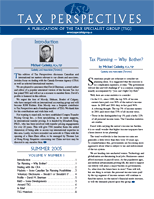
PDF Format
 Issue Contents Issue Contents
 All Issues All Issues
Summer 2005
Volume 5, Number 1
The information in Tax Perspectives is prepared for general interest only. Every effort has been made to ensure that the contents are accurate. However, professional advice should always be obtained before acting and TSG member firms cannot assume any liability for persons who act on the basis of information contained herein without professional advice.
Voluntary Disclosures — Should I or Shouldn't I?
By Ralph H. Green, CA, TEP
Ralph H. Green & Associates
It is not uncommon for a taxpayer to discover a mistake in filing a return or inadvertently fail to report income. If subsequently audited by CRA and the mistake or omission discovered, the taxpayer may be subjected to significant penalties. While no one likes to pay tax, in a self-assessing system, it is imperative that everyone complies with the rules. While one is free to conduct one's affairs so as to minimize tax, this does not include not reporting income! If an advisor becomes aware of situations where a client has unreported income and the client is not willing to make a voluntary disclosure, the advisor must resign from the assignment. The Voluntary Disclosure Program ("VDP") is now administered by the Appeals division of the CRA and is widely used. The VDP can be used to make a disclosure of information not provided (such as foreign reporting forms) or to correct incomplete or inaccurate information or to disclose new information. It can also be used to disclose income not reported on income tax returns, ineligible expenses, or GST, which is underpaid. The purpose of the CRA's VDP is to promote voluntary compliance. The VDP encourages clients to come forward and correct past deficiencies, thereby becoming compliant. The risk and potential for prosecution, penalties, and sleepless nights are often enough incentive to convince a client to make a voluntary disclosure. It is CRA's policy not to impose penalties when a voluntary disclosure is made. CRA approaches the matter in a non-judgmental way. No reason need be given for the non-disclosure. The taxpayer will only be required to pay the tax owing together with interest. The VDP can be used by any delinquent taxpayer - from an individual to a large corporation. The relief provided is determined on a case-by-case basis, but involves as a minimum an up-front waiver of penalties and an agreement not to prosecute. Unpaid taxes and interest, however, must be paid. The program has four conditions: - The disclosure must be voluntary. (A disclosure is not considered voluntary if it arises after the CRA or the tax department of a province has begun an audit, or a request for information has been issued).
- The disclosure must be complete.
- The disclosure must involve a potential penalty. It cannot be used just to make adjustments to a tax return.
- The disclosure must involve information that is at least one year past due. It cannot be used to avoid late-filing penalties for current tax returns.
To make a voluntary disclosure, proceed as follows: - Contact your professional advisor (accountant or lawyer).
- Have your professional advisor contact the VDP section of CRA. Consider making the disclosure on a "No Names" basis while the terms of the disclosure are discussed. The taxpayer's representative can negotiate the details of the disclosure with a VDP officer. If the client does not accept the settlement, the file is closed on a "No Names" basis. If an acceptable disposition of the file has been reached, the representative discloses the client's name and identifying information. This allows a client to be more secure in the knowledge of how the disclosure will be handled. A "No Names" disclosure is considered effective as of the day the representative provides the VDP officer with some identifying information about the disclosure. The first three digits of the client's postal code ensure that the disclosure is being made to the right Tax Services Office. Any audit action started after the disclosure is initiated will not invalidate the disclosure. It should be noted that a final submission should be made within 90 days from the date of the initial submission.
- Ensure that each disclosure is complete and can be verified and that supporting documentation is available upon request.
- Ensure that the client has a plan to pay the taxes owing.
- Do not delay. If you delay and an audit is commenced or an enforcement action is initiated by the CRA, it is unlikely that a voluntary disclosure will be accepted.
If a taxpayer has been dodging taxes and the CRA finds him or her, the taxpayer will have to pay all taxes due as well as late-filing penalties and interest. In some circumstances, a client may be relying on years becoming statute-barred. However, CRA can re-assess in certain circumstances beyond the statute-barred period of three years, so this is no defense. In many voluntary disclosures, there is a range of possible settlements, some better than others. Suppose the disclosure involves foreign investment income, which has not been reported. How many years will the voluntary disclosure cover? Will the CRA go back to the beginning or accept just the past six years (usually the minimum period)? Will the capital sum be treated as unreported income or as capital? The CRA also has some discretion in providing interest relief. This can be beneficial, especially if the disclosure covers many years. Voluntary disclosure is a victory for everyone concerned. The CRA wins because it recovers a portion of back taxes without having to hunt down the taxpayer. The taxpayer wins peace of mind. The taxpayer's identity is protected and the possible penalties and/or imprisonment are avoided.
| 




